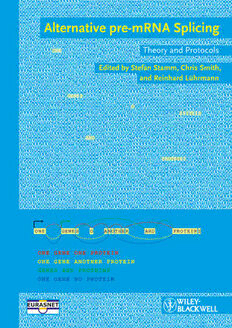Table Of ContentEditedby
StefanStamm,ChrisSmith,
andReinhardLührmann
Alternativepre-mRNASplicing
Related Titles
Hartmann, R.K., Bindereif, A., Schön,A.,Westhof, E. (eds.)
Handbook of RNA Biochemistry
StudentEdition
2009
ISBN:978-3-527-32534-4
Miller,L. W.(ed.)
Probes and Tags to Study Biomolecular Function
forProteins,RNA,andMembranes
2008
ISBN:978-3-527-31566-6
Smith,H.C. (ed.)
RNA and DNA Editing
MolecularMechanismsandTheirIntegrationintoBiologicalSystems
2008
ISBN:978-0-470-10991-5
Edited by
Stefan Stamm, Chris Smith, and Reinhard Lührmann
Alternative pre-mRNA Splicing
Theory and Protocols
TheEditors LimitofLiability/DisclaimerofWarranty:Whilethe
publisherandauthorhaveusedtheirbesteffortsin
Prof.Dr.StefanStamm preparingthisbook,theymakenorepresentationsor
UniversityofKentucky warrantieswithrespecttotheaccuracyorcomplete-
DepartmentofMolecularandCellularBiochemistry nessofthecontentsofthisbookandspecifically
741,SouthLimestoneStreet disclaimanyimpliedwarrantiesofmerchantabilityor
Lexington,KY40536-0298 fitnessforaparticularpurpose.Nowarrantycanbe
USA createdorextendedbysalesrepresentativesorwritten
salesmaterials.TheAdviceandstrategiescontained
hereinmaynotbesuitableforyoursituation.You
Prof.Dr.ChrisSmith shouldconsultwithaprofessionalwhereappropriate.
Neitherthepublishernorauthorsshallbeliablefor
UniversityofCambridge
DepartmentofBiochemistry anylossofprofitoranyothercommercialdamages,
TennisCourtRoad includingbutnotlimitedtospecial,incidental,con-
sequential,orotherdamages.
CambridgeCB21QW
UnitedKingdom
LibraryofCongressCardNo.:appliedfor
BritishLibraryCataloguing-in-PublicationData
Prof.Dr.ReinhardLührmann
Acataloguerecordforthisbookisavailablefromthe
MaxPlanckInstitute
BritishLibrary.
forBiophysicalChemistry
DepartmentofCellularBiochemistry Bibliographicinformationpublishedby
AmFassberg11 theDeutscheNationalbibliothek
37077Göttingen TheDeutscheNationalbibliothekliststhispublica-
Germany tionintheDeutscheNationalbibliografie;detailed
bibliographicdataareavailableontheInternetat
http://dnb.d-nb.de.
(cid:2)2012Wiley-VCHVerlag&Co.KGaA,Boschstr.12,
69469Weinheim,Germany
Cover
mRNAsplicingistheprocessthatallowsthecellto
Wiley-BlackwellisanimprintofJohnWiley&Sons,
joinpartsofthepre-mRNAtoformamaturemRNA formedbythemergerofWiley’sglobalScientific,
thatisexportedintothecytosolandisusedasa
Technical,andMedicalbusinesswithBlackwell
templateforsynthesisofproteins.Mostofthe
Publishing.
pre-mRNAconsistsofintronicsequencesthatare
removedinthenucleusandsubsequentlydegraded. Allrightsreserved(includingthoseoftranslationinto
Thevastmajorityofhumangenesundergo
otherlanguages).Nopartofthisbookmayberepro-
alternativepre-mRNAsplicing,whereexonsare ducedinanyform–byphotoprinting,microfilm,or
combinedtoencodedifferentproteinisoforms.The anyothermeans–nortransmittedortranslatedintoa
coverillustratesthetaskofthecelltopreciselyfind machinelanguagewithoutwrittenpermissionfrom
meaningful‘words’,theexons,inthevastamountof thepublishers.Registerednames,trademarks,etc.
surroundingintronicsequences.Theseexonscanbe usedinthisbook,evenwhennotspecificallymarked
combinedalternativelytogiveproteinswithdifferent, assuch,arenottobeconsideredunprotectedbylaw.
sometimesantagonisticfunctions.Alternative
splicingisoftencoupledwithalternativepromoter Typesetting ThomsonDigital,Noida,India
usage(arrows)andpolyadenylation(gapinthelast Printing FabulousPrintersPteLtd,Singapore
word),whichfurtherincreasesthecapacityofthecell Binding FabulousPrintersPteLtd,Singapore
toexploititsgeneticinformation.Thefigureillus- CoverDesign Formgeber,Eppelheim
trateshowalternativesplicingtransformsthe“one
geneoneprotein”principlethatdevelopedfromthe PrintedinSingapore
classicexperimentsofGeorgeBeadleandEdward Printedonacid-freepaper
Tatumin1941(Proc.Natl.Acad.Sci.USA,27(1941)
499–506). PrintISBN: 978-3-527-32606-8
ePDFISBN: 978-3-527-63678-5
ePubISBN: 978-3-527-64798-9
mobiISBN: 978-3-527-64799-6
oBookISBN: 978-3-527-63677-8
j
V
Contents
Preface XXIII
ListofAbbreviations XXV
ListofContributors XXXI
PartOneTheory 1
1 SplicingintheRNAWorld 3
EmanueleBuratti,MaurizioRomano,andFranciscoE.Baralle
1.1 Introduction:TheFascinationofAlternativePre-mRNASplicing 3
1.2 RNACanAdoptaFlexibleConformation 4
1.3 EnzymaticRNAsandtheRNAWorld 5
1.4 CommonClassesofEukaryoticRNA 6
1.5 AlternativePre-mRNASplicingasaCentralElementofGeneExpression 8
1.6 IncreasingNumbersofHumanDiseasesareAssociatedwithWrong
SpliceSiteSelection 9
References 11
2 RNPs,SmallRNAs,andmiRNAs 13
MichaelaBeitzingerandGunterMeister
2.1 Introduction 13
2.2 RibonucleaseP(RNaseP) 14
2.3 SmallNucleolarRNAs(snoRNAs) 15
2.4 SmallRegulatoryRNAs 16
2.4.1 ShortInterferingRNAs(siRNAs) 16
2.4.2 MicroRNAs(miRNAs) 17
2.4.3 Piwi-InteractingRNAs(piRNAs) 17
2.5 7SLRNA 17
2.6 7SKRNA 18
2.7 U-RichSmallNuclearRNAs(UsnRNAs) 18
References 18
3 RNAElementsInvolvedinSplicing 21
WilliamF.MuellerandKlemensJ.Hertel
3.1 Introduction 21
3.2 SpliceSiteSequence 22
3.3 Intron/ExonArchitecture 23
3.4 SplicingRegulatoryElements(SREs) 24
3.5 RNASecondaryStructure 26
3.6 CouplingbetweenTranscriptionandRNAProcessing 27
3.7 CombinatorialEffectsofSplicingElements 28
References 29
j
VI Contents
4 AStructuralBiologyPerspectiveofProteinsInvolvedin
SplicingRegulation 33
AntoineCl(cid:2)eryandFr(cid:2)ed(cid:2)ericH.-T.Allain
4.1 Introduction 33
4.2 TheRRM:AVersatileScaffoldforInteractingwithMultipleRNA
SequencesandalsoProteins 35
4.2.1 RRM–RNAInteractionandSplicingRegulation 35
4.2.1.1 RNABindingbySplicingFactorsContainingaSingleRRM 36
4.2.1.2 RNABindingbySplicingFactorsContainingMultipleRRMs 37
4.2.2 RRM–RRMandRRM–ProteinInteractionsinSplicingRegulation 41
4.2.2.1 RRM–ProteinInteractionsWithoutRNABinding 41
4.2.2.2 RRM–ProteinInteractionsAllowingRNABinding 41
4.2.2.3 ImpactofRRM–RRMInteractionsonSplicingMechanism 42
4.3 TheZincFingerDomain 42
4.4 TheKHDomain 44
4.5 ConclusionsandPerspectives 45
References 46
5 TheSpliceosomeinConstitutiveSplicing 49
PatriziaFabrizioandReinhardLu€hrmann
5.1 Introduction 49
5.2 TheMechanismofSplicing 49
5.3 TheStepwiseAssemblyPathwayoftheSpliceosome 51
5.4 DynamicsoftheSpliceosomalRNA-RNARearrangements 53
5.5 Splice-SiteRecognitionandPairingInvolvestheCoordinated
ActionofRNAandProteins 55
5.6 DrivingForcesandMolecularSwitchesRequiredDuringthe
SpliceosomesActivationandCatalysis 55
5.7 AConformationalTwo-StateModelfor
theSpliceosomesCatalyticCenter 56
5.8 CompositionalDynamicsandComplexityoftheSpliceosome 57
5.9 ReconstitutionofBothStepsofS.cerevisiaeSplicingwith
PurifiedSpliceosomalComponents 61
5.10 EvolutionarilyConservedBlueprintfor
YeastandHumanSpliceosomes 61
5.11 ConcludingRemarks 63
References 63
6 TheUseofSaccharomycescerevisiaetoStudytheMechanism
ofpre-mRNASplicing 65
BrianC.Rymond
6.1 Introduction 65
6.2 TheBasicsofSplicing 65
6.3 YeastIntron–ExonOrganization 66
6.4 TheYeastSpliceosome 67
6.5 DefiningtheConstellationofYeastSplicingFactors:
PrimaryScreensandGenomicInspection 68
6.6 ReporterGenesasReadoutsofSplicingEfficiency 69
6.7 GeneticInteraction:DosageSuppressionorAntagonism 70
6.8 ExtragenicSuppressors 70
6.9 SyntheticLethality 71
6.10 SystematicApproachestoDefinetheInteractome 72
References 74
7 ChallengesinPlantAlternativeSplicing 79
AndreaBarta,YamileMarquez,andJohnW.S.Brown
7.1 Introduction 79
j
Contents VII
7.2 PlantIntrons 80
7.3 ThePlantSpliceosome 81
7.4 PlantSpliceosomalProteins 86
7.5 AlternativeSplicinginPlants 88
References 90
8 AlternativeSpliceSiteSelection 93
MiguelB.CoelhoandChristopherW.J.Smith
8.1 Introduction 93
8.2 ThePlayers:SplicingRegulators 95
8.3 TheStage:TheSplicingComplexAssemblyandExonDefinition 96
8.4 SwitchingSplicingPatterns 99
8.5 SrcN1Exon:AModelofCombinatorialSplicingRegulation 101
8.6 TheGlobalView:TowardsaSplicingCode 103
References 104
9 IntegrationofSplicingwithNuclearandCellularEvents 109
AparnaK.SapraandKarlaNeugebauer
9.1 Introduction 109
9.2 Overview 109
9.3 NuclearStructureandDistributionofSplicingFactors 110
9.3.1 CajalBodies(CBs) 111
9.3.2 SplicingFactorCompartments(SFCs)/Speckles 111
9.3.3 Paraspeckles 111
9.4 IntegrationofSplicingwithNuclearandCellularProcesses 111
9.4.1 SplicingandTranscription 112
9.4.2 SplicingandmRNACapping 112
9.4.3 Splicingand30 EndProcessing 113
9.4.4 SplicingandExport 113
9.4.5 SplicingandTranslation 114
9.4.6 SplicingandNonsense-MediatedDecay(NMD) 114
9.4.7 SplicingandChromatinStructure 115
References 115
10 SplicingandDisease 119
EmanueleBurattiandFranciscoE.Baralle
10.1 Introduction 119
10.2 SplicingandDisease 120
10.3 TherapeuticApproaches 121
10.4 TheGenerationofAberrantTranscripts 122
10.5 ExonSkipping 122
10.6 CrypticSpliceSiteActivation 122
10.7 IntronRetention 123
10.8 PseudoexonInclusion 124
10.9 UnexpectedSplicingOutcomesFollowingtheDisruptionofClassical
SplicingSequences 124
10.10 Conclusions 125
References 125
11 FromBedsidetoBench:HowtoAnalyzeaSplicingMutation 129
MarcoBaralleandDianaBaralle
11.1 Introduction 129
11.2 FromClinicalEvaluationtoMutationTesting 130
11.3 AnExampleofanUncertainDiagnosis 132
11.4 MutationTestingProcedures 133
11.4.1 In-VitroSplicing 134
11.4.2 MinigeneSplicing 134
j
VIII Contents
11.5 ConcludingRemarks 136
References 137
PartTwoBasicMethods 139
12 AnalysisofCommonSplicingProblems 141
StefanStamm
12.1 Introduction 141
12.2 IsaMutationCausingaChangeinAS? 142
12.3 HowisaSplicingEventRegulated,andHowCanitbeInfluenced? 143
12.4 IsThereaDifferenceinAlternativepre-mRNAProcessingBetween
TwoCellPopulations? 144
References 145
13 UltracentrifugationintheAnalysisandPurificationofSpliceosomes
AssembledInVitro 147
KlausHartmuth,MariaA.vanSanten,andReinhardLu€hrmann
13.1 TheoreticalBackground 147
13.2 Protocol 148
13.2.1 PreparationoftheGradient 148
13.2.1.1 ManualGradientFormation 148
13.2.1.2 AutomaticGradientFormationwiththeGradientMaster 149
13.2.2 PreparingtheRun 150
13.2.2.1 LoadingtheSample 150
13.2.2.2 SedimentationMarkers 150
13.2.3 TheUltracentrifugeRun 150
13.2.4 HarvestingtheGradient 150
13.3 ExampleExperiment 151
13.3.1 PurificationoftheSpliceosomalBComplex 151
13.3.1.1 Preliminaries 151
13.3.1.2 PreparationoftheSpliceosomalBComplex 151
13.4 Troubleshooting 153
References 153
14 ChemicalSynthesisofRNA 155
ClaudiaH€obartner
14.1 TheoreticalBackground 155
14.1.1 RNASolid-PhaseSynthesis 155
14.1.2 RNAModifications 158
14.1.2.1 RNAModificationDuringSolid-PhaseSynthesis 158
14.1.2.2 Post-SyntheticRNAModification 158
14.1.3 CombinedChemicalandEnzymaticStrategies 158
14.2 RepresentativeProtocols 160
Protocol1:IncorporationofModifiedPhosphoramiditesDuring
Solid-PhaseSynthesis 160
Protocol2:CouplingofBiophysicalProbestoAliphaticAmino
GroupsonRNA 160
Protocol3:EnzymaticLigationofRNAfragmentsusing
T4RNAorT4DNALigase 160
14.3 Troubleshooting 161
References 161
15 RNAInterference(siRNA,shRNA) 165
DaphneS.CabiancaandDavideGabellini
15.1 TheoreticalBackground 165
15.1.1 RNAi 165
15.1.2 siRNAsandshRNAs 165
j
Contents IX
15.1.3 Lentiviral-MediatedRNAi 167
15.2 Protocol 167
15.2.1 MapofpLKO.1Puro 167
15.2.2 OligonucleotideDesign 167
15.2.2.1 DeterminingtheOptimal21-merTargetsintheGene 167
15.2.2.2 OrderingOligosCompatiblewithpLKO.1 168
15.2.3 GeneratingthepLKO.1PurowithashRNAConstruct 169
15.2.3.1 AnnealingoftheOligonucleotides 169
15.2.3.2 PreparationofpLKO.1TRCforCloning 169
15.2.3.3 LigatingandTransformingintoBacteria 169
15.2.3.4 ScreeningforInserts 169
15.2.4 ProductionofLentiviralParticles 169
15.2.5 LentiviralInfection 170
15.3 ExampleExperiment 171
15.4 Troubleshooting 172
References 172
16 ExpressionandPurificationofSplicingProteins 175
JamesSt(cid:2)eveninandCyrilF.Bourgeois
16.1 TheoreticalBackground 175
16.2 Protocol1:ThePreparationofTotalHeLaSRProteins 175
16.2.1 ExampleExperiment 176
16.2.2 TroubleshootingandImportantPoints 177
16.3 Protocol2:ThePurificationofIndividualSRProteins 177
16.3.1 ExpressionofSRProteinsinEscherichiacoliandPurification 177
16.3.2 PreparationofSRProteinsUsingaBaculovirusSystem 178
16.3.3 ExampleExperiment 178
16.3.4 TroubleshootingandImportantPoints 178
16.3.5 ProductionandPurificationofIndividualSRProteinsinMammalian
Cells 179
References 179
17 DetectionofRNA–ProteinComplexesbyElectrophoreticMobilityShift
Assay 183
ManliShenandMichaelG.Fried
17.1 TheoreticalBackground 183
17.1.1 ChoiceofRNASubstrate 184
17.1.2 DetectionandQuantitationofBinding 184
17.1.3 Fluorescence 185
17.1.4 ChromogenicandChemiluminescentDetectionMethods 186
17.1.5 StabilityofRNA–ProteinComplexesDuringElectrophoresis 186
17.1.6 CompetingNucleicAcidsandPolyanions 187
17.1.7 BindingStoichiometry 187
17.1.8 MeasurementofBindingActivity 187
17.1.9 MeasurementofDissociationConstants 188
17.1.10 BindingCompetition 190
17.2 Protocol 190
17.2.1 Equipment 191
17.2.2 Reagents 191
17.2.3 GelPreparation 191
17.2.4 Pre-Electrophoresis 192
17.2.5 SamplePreparation 192
17.2.6 ElectrophoresisandImaging 193
17.3 ExampleExperiment 194
17.4 Troubleshooting 195
References 196
j
X Contents
18 FunctionalAnalysisofLargeExonicSequencesThrough
IterativeInVivoSelection 201
RavindraN.SinghandNataliaN.Singh
18.1 TheoreticalBackground 201
18.1.1 SpinalMuscularAtrophy 202
18.2 Protocol 202
18.2.1 Minigene,CellCulture,Transfection,andInVivoSplicing
Assay 202
18.2.2 GenerationofaPartiallyRandomExon 204
18.2.3 InvivoSelection 204
18.2.4 AnalysisofSequences 204
18.3 ExampleExperiment 205
18.3.1 GeneratingtheInitialPoolofSplicingCassettes 206
18.3.2 InVivoSelectionProcedure 207
18.4 Troubleshooting 209
References 209
19 IdentificationofSplicingcis-ElementsThroughanUltra-Refined
AntisenseMicrowalk 211
NataliaN.Singh,JoonbaeSeo,andRavindraN.Singh
19.1 TheoreticalBackground 211
19.2 Protocol 212
19.2.1 OligonucleotideDesignandSynthesis 212
19.2.2 CellCulture,Transfection,andInVivoSplicingAnalysis 212
19.2.3 ValidationofSpecificity 212
19.3 ExampleExperiment 214
19.4 Troubleshooting 216
References 217
20 GenomicSELEXtoIdentifyRNATargetsofPlant
RNA-BindingProteins 219
OlgaBannikova,MariaKalyna,andAndreaBarta
20.1 Introduction 219
20.2 Protocols 221
20.3 ExampleExperiment 225
20.4 Troubleshooting 225
References 226
PartThreeDetectionofSplicingEvents 227
21 QuantificationofAlternativeSpliceVariants 229
MiriamLlorianandChristopherW.J.Smith
21.1 TheoreticalBackground 229
21.1.1 PCRforSpliceVariantQuantification 229
21.1.2 ConventionalRT-PCR 230
21.1.3 Real-TimePCR:ChemistryandQuantificationMethods 230
21.1.4 PrimerDesign 232
21.2 Protocol 233
21.2.1 RNAExtraction 233
21.2.2 DNaseTreatment 233
21.2.3 ReverseTranscriptaseReaction 233
21.2.4 RadiolabeledPCR 233
21.2.5 qPCRReactions 234
21.2.6 DataAnalysis 234
21.3 ExampleExperiment:MicroarrayValidationofPTB-Regulated
Events 234

